



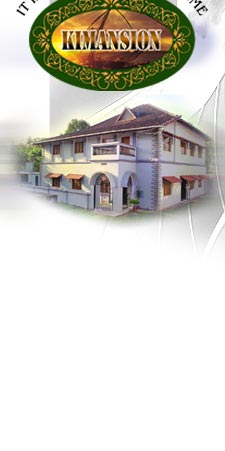
 |
||
|
THE MELTING POT OF CULTURES
The commercial capital of Kerala and the most cosmopolitan of Kerala’s cities, Cochin is a fascinating blend of cultures. From time immemorial, it has been the favorite destination of globe-trotters and explorers. Blessed by one of the finest natural harbors in the world, Cochin has been eulogised as the Queen of the Arabian Sea. In and around Cochin are several cities of monumental value, but step into Fort Cochin, and you are in a totally different world. The Chinese fishing nets, the Jewish Synagogue, the Dutch palace, the Portuguese and British Architecture, all finely blend with the rich heritage of the land, intricately woven folklore and fact. Reaching Fort Cochin With an international airport, an international sea port and a busy network of road and rail transport, the city is well connected to the rest of the world. You can either board a bus or hire a three-wheeled auto rickshaw. If you prefer the ferry, the trip begins either from the Main Boat Jetty or the Terminus Jetty near Willington Island.
Walking through Fort Cochin Walking through this old Portuguese settlement at a leisurely pace, will take you up to an hour and a half. The most pleasant time for the walk is between 9 am and 12 noon or between 3 pm and 6 pm. The most ideally suited attire in this sub tropical country is cottons and soft walking shoes or thong. A wide-brimmed straw hat is of great help on a sunny day. Fort Cochin. Where time stands still "If China is where you make your money, then Cochin is surely the place to spend it." When Nicolas Conti, the legendary Italian traveler said this, Cochin was flourishing in trade as one of the most desirable destinations approachable by sea. And Fort Cochin, once an obscure fishing hamlet, found itself at the hub of all this bustling activity. It was soon to be the first European township in trade as one of the most glorious cities in its history. Fort Cochin probably has the best preserved history of colonial times and the ideal way to bring it alive is to take a walk down its old colonial roads, with its tree-lined avenues and quaint little lands and beside the seashores – where magnificent Chinese fishing nets sketch a spectacular skyline. It is believed that Chinese travelers during the reign of Kubla Khan had introduced this art of Chinese fishing to Cochin. In AD 1341, a cataclysmic flood threw open the estuary at Cochin. Thanks to the strange ways of nature, out of this land-locked area was born one of the finest natural harbors of the east. This in turn paving the way for a deluge of seafaring visitors, from the Arabs to the Chinese and later, from the Portuguese to the British. The features of the latter ones characterize the façade of Fort Cochin, to a great extent. The Portuguese Walking through Fort Cochin will transport you back to the last years of the 15th century. When the adventurous Vasco da Gamma and valiant Cabral let their religions to this land lured by the fabulous riches of Malabar Coast and established flourishing trade relations. In 1553 with the permission of Maharaja of Cochin, Fort Immanuel , the first European Fort in India was constructed here. Within its vast confines, the Portuguese built houses, Churches and other buildings while generously contributing to the indigenous cultural fabric, the standard of which still endures. The Dutch Designs While
traveling down the streets of Fort Cochin, the Dutch influence is
profound, they laid out most of the town in its present form. In
doing this, they cut down the Fort to about a third of its original
extent, when they wrested it from the Portuguese in AD 1663. The British The last side of colonial regime seen at the Fort Cochin are those of British, who took over the town in 1795.After those glorious years it was then relegated to the role of an administrative outpost. Yet, the spices and tea trade kept it in the lime light. In many of the Bungalows here, you will notice the grandeur of European Villa; evidence of distinct strain of Indo/European Architecture that matured mostly in this period. Detours into the past After the enlightening walk through Fort Cochin, and if ones curiosity is still asking for more, walk on for the Jewish settlements of Mattancherry is just 20 minutes away. The Dutch Palace and the Jewish Synagogue, that are over 400 years old, are places where you can treat be immersed in the glorious past of this land. Chinese Fishing Nets/Vasco da Gamma Square These huge cantilevered fishing nets are the legacy of one of the first visitors to Malabar Coast. Erected here between 1350 and 1450 AD by traders from the Court of Kubla khan, these nets are set up on teak wood and bamboo poles. The best place to watch the net being lowered into the sea and catch being brought in is Vasco da Gamma square, a narrow promenade that runs along along the Beach. The square is an ideal place to idle with stalls serving fresh delicious sea food and tender coconuts. Santa Cruz Basilica
St. Francis Church
The Dutch Cemetery The tomb stones here are the most authentic record of the hundreds of Europeans who left their homeland on a mission to expand their colonial empires and changed the course of history of this land. The cemetery was consecrated in 1724 and is today managed by the Church of South India. Jewish
Synagogue |
|
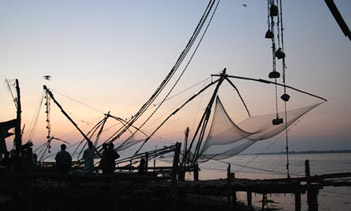
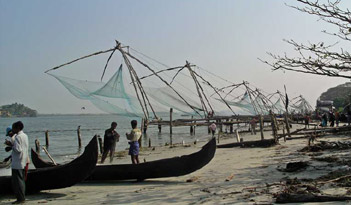
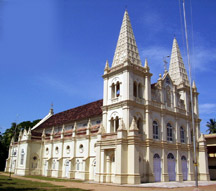 This
historic Church was built by the Portuguese and elevated to a Cathedral
by Pope Paul IV in 1558. In 1795 it fell into the hands of the British
when they took over Cochin, and was demolished.
This
historic Church was built by the Portuguese and elevated to a Cathedral
by Pope Paul IV in 1558. In 1795 it fell into the hands of the British
when they took over Cochin, and was demolished.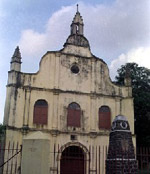 Built
in 1503 by Portuguese Franciscan Friars, this is India’s oldest
European Church. This was initially built of timber and later reconstructed
in stone masonry. It was restored in 1779 by the Protestant Dutch,
converted to an Anglican Church by the British in 1795 and is at
present governed by the Church of South India. Vasco da Gamma was
buried here in 1524 before his remains were moved to Lisbon, Portugal.
The tombstone can still be seen in the premises.
Built
in 1503 by Portuguese Franciscan Friars, this is India’s oldest
European Church. This was initially built of timber and later reconstructed
in stone masonry. It was restored in 1779 by the Protestant Dutch,
converted to an Anglican Church by the British in 1795 and is at
present governed by the Church of South India. Vasco da Gamma was
buried here in 1524 before his remains were moved to Lisbon, Portugal.
The tombstone can still be seen in the premises.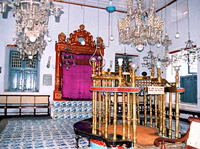 The
exquisite hand painted blue Chinese tiles offer an interesting sight.
Not one of the nearly two hundred year old tiles resembles another.
In mid-18th century, the clock tower was added. There are several
finely wrought gold and silver crowns gifted to the synagogue by
the various patrons
The
exquisite hand painted blue Chinese tiles offer an interesting sight.
Not one of the nearly two hundred year old tiles resembles another.
In mid-18th century, the clock tower was added. There are several
finely wrought gold and silver crowns gifted to the synagogue by
the various patrons